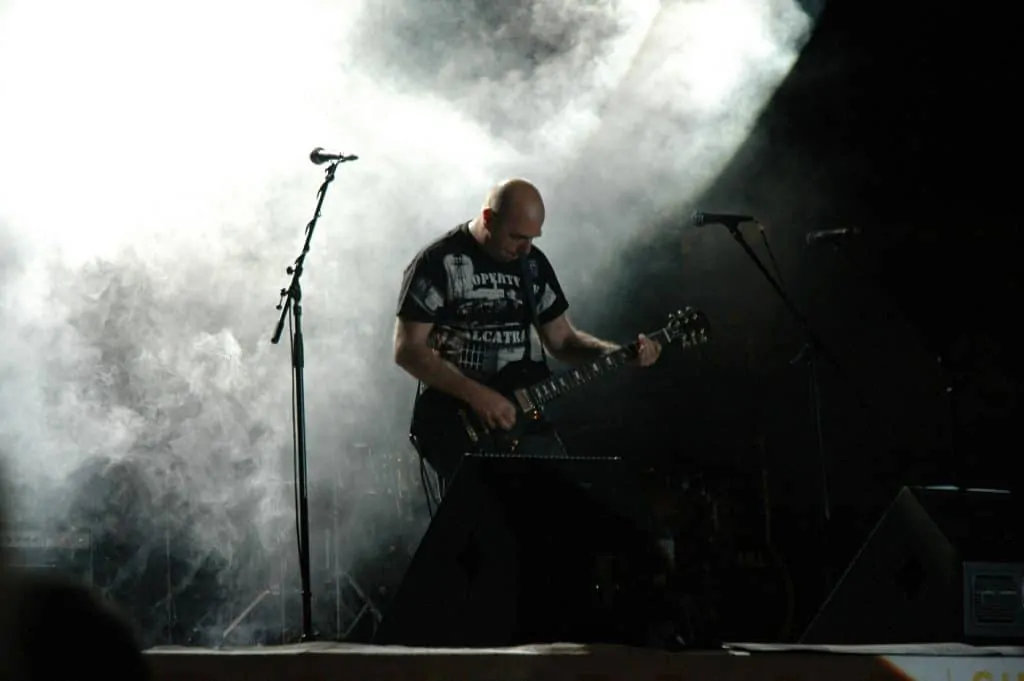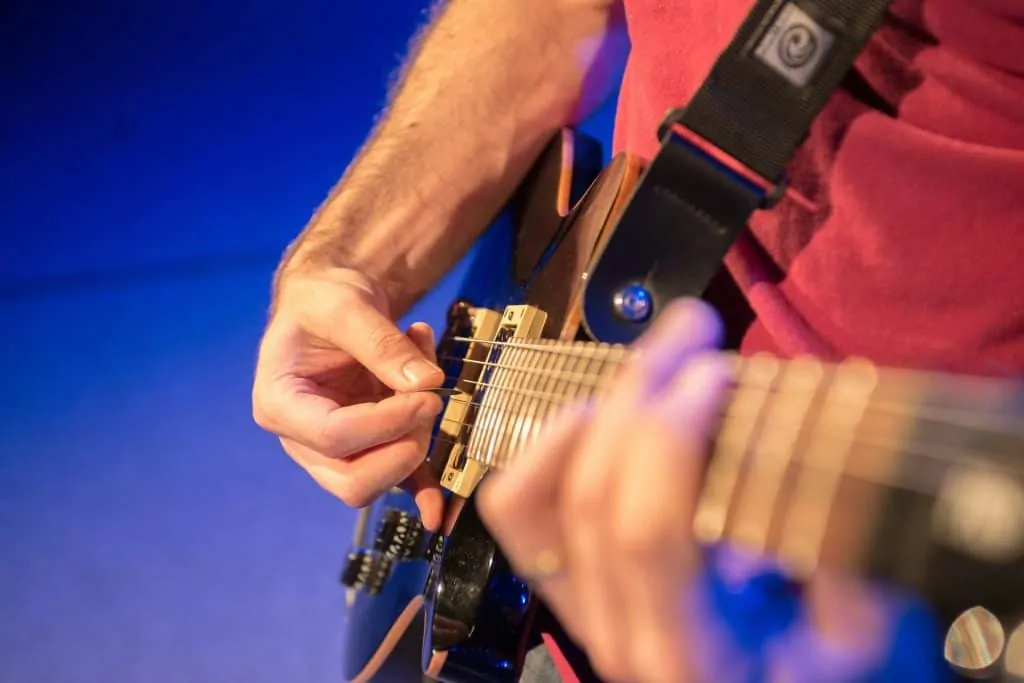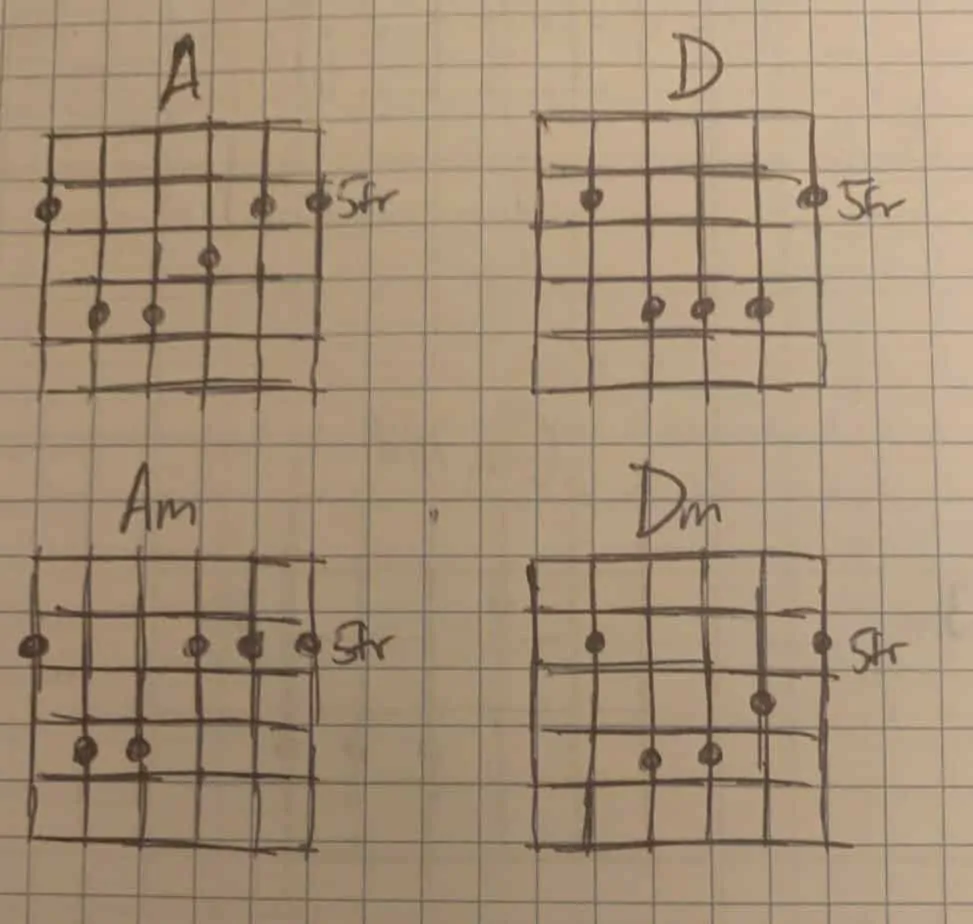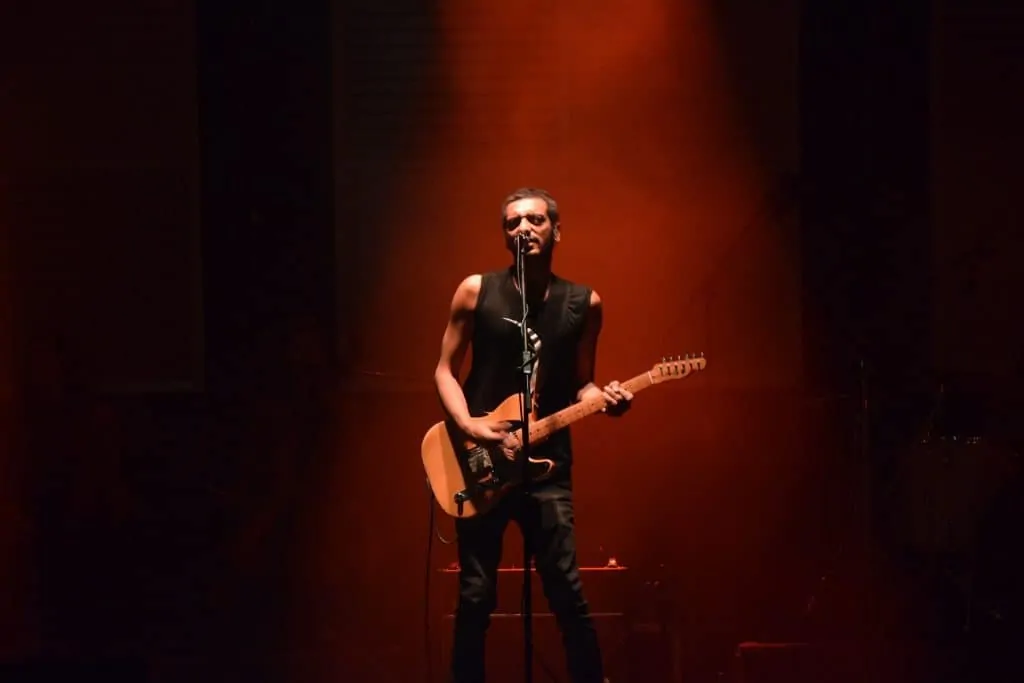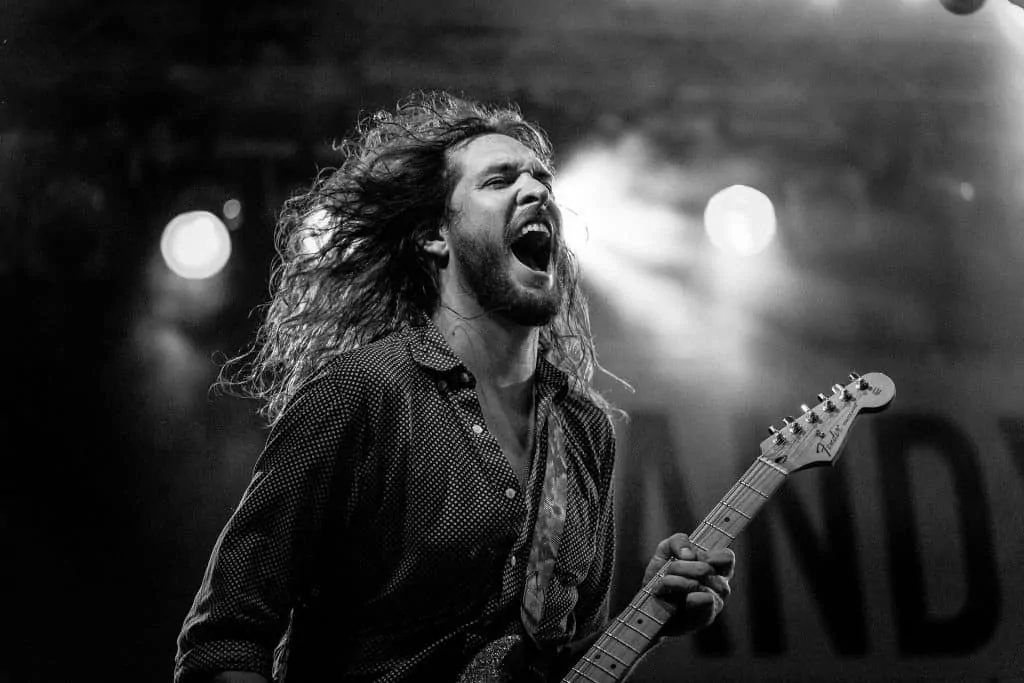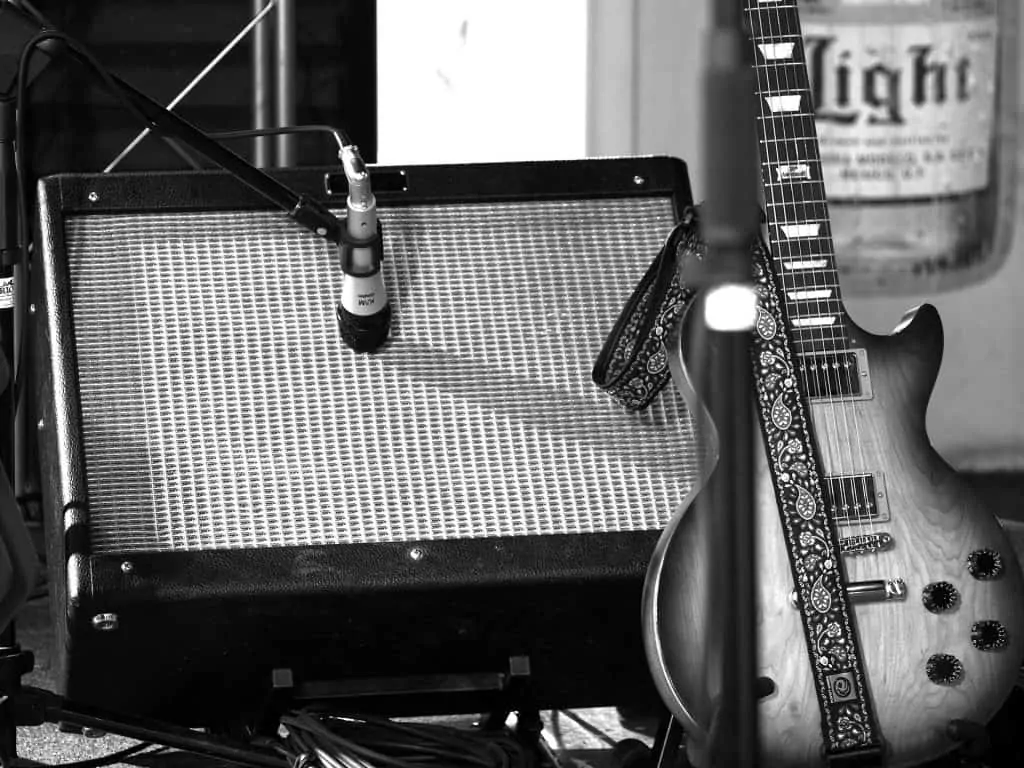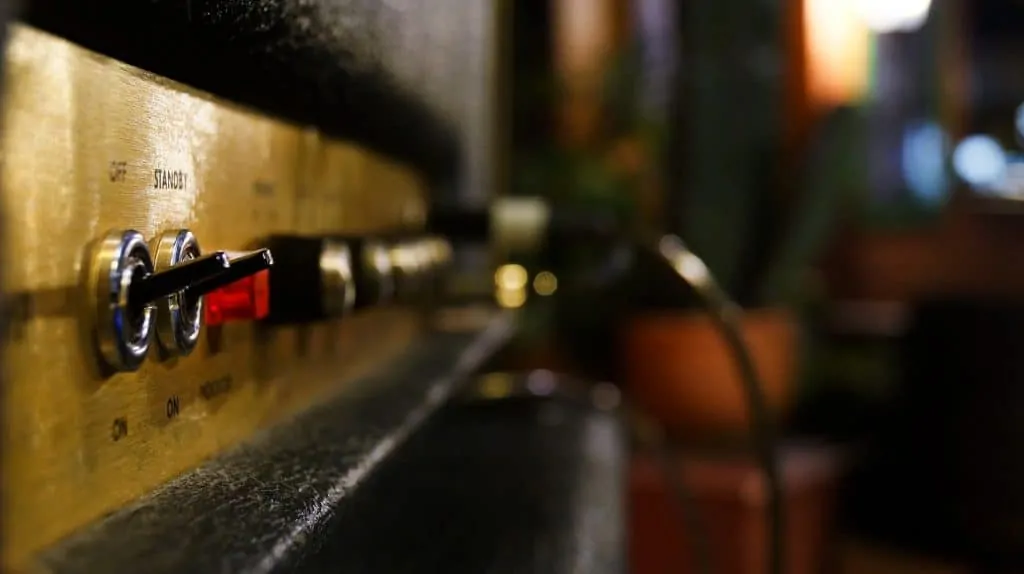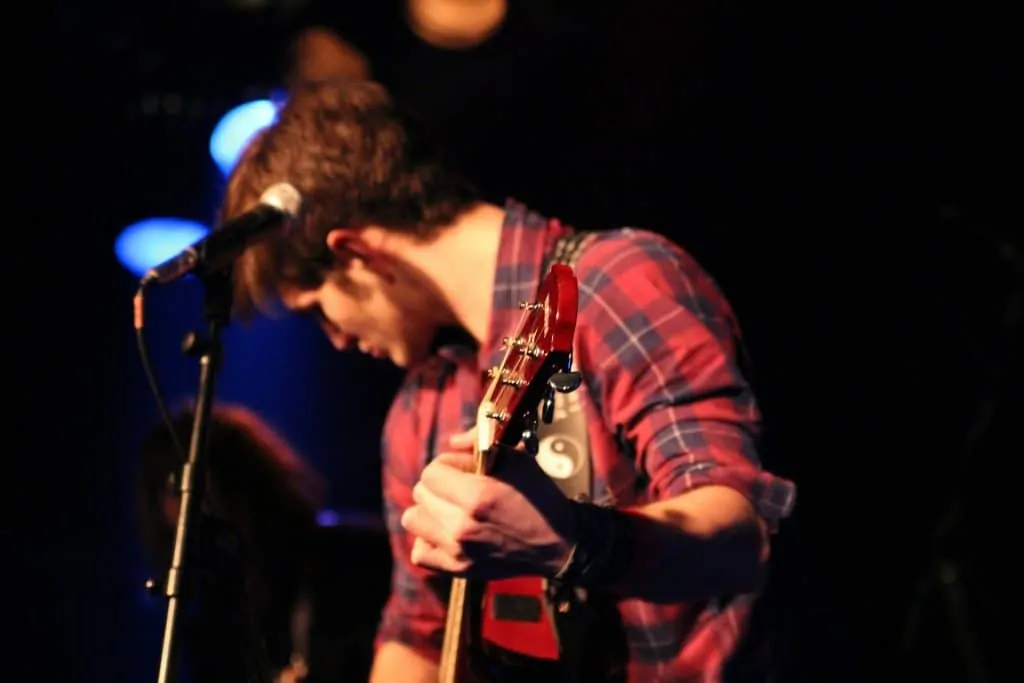Led by groups like the Sex Pistols, The Clash, the Ramones, and the Buzzcocks, punk rock rode a wave of reactionary sentiment against more buttoned-up music and mainstream culture to become the dominant genre of the late 1970s and early 1980s. The revival of pop-punk in the early 1990s also made stars out of a new generation of punk rockers, including famous bands like Green Day and blink-182.
Many punk songs are easy enough for beginner guitarists to play — early punk rockers were often beginner players on their instruments themselves, learning to play by ear — but the genre also has more complex pieces and techniques for proficient guitarists to work on. This guide covers what you need to know to play punk rock on guitar, whether you’ve never listened to punk in your life or just can’t get enough of it.
Punk rock guitar embraces a dirty, heavy sound.
Contents
Characteristics of Punk Rock Guitar
Punk rock, like many other famous genres, was born out of a reaction to what many youth perceived as a bleak, plastic mainstream culture in the early 1970s. The first punk rockers were making a statement along with their music; they deliberately went against the grain of popular music at the time.
That meant that the early punk rockers outright rejected many features of classic rock, disco, jazz and funk. Where those genres featured syncopated rhythms, multiple instruments in the groove, and oftentimes created space for instrumental solos, punk was straightforward, simple, and didn’t have any time for extended improvisation.
Punk rock is dominated by loud, distorted electric rhythm guitar. Though previous genres like blues, psychedelic rock, and classic rock had all experimented with distortion, punk rock brought a harder, nastier edge to the sound of guitar-centric music.
The majority of punk rock guitarists play with quick, choppy downstrokes and not much variation in strumming patterns. Power chords, like in grunge and much of alternative rock, reign supreme. Chord progressions usually feature four or fewer chords, which are often accessible on guitar simply by sliding a power chord shape up and down the sixth string.
Many original punk bands, like the Sex Pistols, didn’t even bother with a lead guitarist. The concept of “lead playing,” with single-note accents inserted between vocal lines and improvised solos, is practically nonexistent across much of the punk rock scene. Guitar solos are looked at with disdain, if not flat-out rejected.
Modern pop-punk typically displays a similar aversion to traditional lead guitar. While ‘90s groups like Green Day may feature more pop songwriting skills than, say, Johnny Rotten, the majority of punk revival bands prefer a power trio format with one guitarist playing rhythm to a four-piece setup with an additional lead player.
While some bands — the Ramones are a great example — crafted tightly orchestrated grooves and played with precision and time, other groups extended the rebellious aspect of punk rock into their playing itself. Punk rock songs are often intentionally sloppy, with errors and inconsistencies left on tape that other mainstream bands might have edited out.
That wild, nearly out-of-control feel characterizes punk rock. Though the genre features a wealth of different techniques and styles to learn, feeling the beat and playing with the proper attitude may be some of the most important tips any beginner punk guitarist must remember.
Punk rock encompasses multiple different styles over different decades of music.
Famous Punk Rock Guitar Players
Most music historians credit two bands with starting the punk rock revolution: the Ramones and the Sex Pistols. While the Ramones were American and the Sex Pistols British, both bands created a frenetic, stripped back sound that ran directly counter to the exorbitant trends of other pop.
Johnny Ramone (born John William Cummings) practically created the early punk guitar sound with the Ramones. He became known for using only downstrokes in his playing — a radical technique that gave the Ramones a much more aggressive sound than their contemporaries, as well as helping Johnny keep consistent time. His reliance on full barre chords is also notable; when combined with the Ramones’ high distortion it created a forceful “wall of sound” effect.
Another driving force on the 1970s punk scene, Sex Pistols guitarist Steve Jones had only been playing the instrument for three months when the group recorded their landmark debut record Never Mind The Bollocks, Here’s The Sex Pistols.
While he was hardly a technically proficient guitarist, Jones managed to create a punk rock opus with his rolling, chugging waves of rhythm guitar. Like Johnny Ramone, Jones’ heavy distorted sound (achieved with his trademark Les Paul Custom guitars) became a staple in punk bands thereafter.
Dubbed “the only band that matters” during their heyday at the turn of the 1980s, The Clash became the standard for punk rock bands behind the fierce, raw energy of lead guitarist Mick Jones.
Though he incorporated the reckless rhythm playing of earlier punk rockers like Steve Jones and Ramone, Mick Jones’ work with The Clash brought an increasingly melodic, lead-focused side to punk. His fiery, pointed solos were some of the first in mainstream punk, redefining the bounds of the genre. As The Clash took on influences from styles like reggae and rockabilly, Jones adapted while maintaining the punk energy throughout.
Pete Shelley, lead guitarist and songwriter of Manchester band The Buzzcocks, merits a mention as an innovator in the 1970s punk scene. He took the punk guitar style beyond the traditional three-chord form and brought greater pop appeal to jagged, hard-driving power chords.
The American band Dead Kennedys became incredibly controversial for their name, lyrics, and musical style — though the work of lead guitarist East Bay Ray displays a creative and witty approach to the punk idiom. Fusing the surf guitar picking of players like Dick Dale with the punk aesthetic of the Sex Pistols, East Bay Ray led the second wave of American punk through the 1980s.
Punk rock was eclipsed by new wave and indie on the charts for much of the 1980s, but a new generation of pop-punk rockers brought the genre back to form in the 1990s with an updated sound and vintage feel. Chief among them was Green Day’s Billie Joe Armstrong, whose Ramones-esque guitar attack made the 1994 album Dookie a commercial success and critical classic.
Another California group, blink-182, rode their blend of traditional punk guitar style and chords with skater and emo pop lyrics to MTV airplay and strong sales around the turn of the millennium. Founding guitarist Tom DeLonge became one of the leading pop-punk guitarists of the new generation.
Most punk songs use power chords, shifted up and down to different frets.
Chords and Melody
Punk rock songs are among the most simple songs out there. Most employ just four chords, and some (like the Ramones’ hit “Blitzkrieg Bop”) use only three. These chords are overwhelmingly some of the same chords found in blues, rock, and other popular music.
If you’re learning how to play punk rock, you should start out by studying your classic barre chords. Having a strong grasp of the CAGED system chords can be helpful if you want to play the different chords to a song in the same spot on the neck, though many punk rockers simply slide up and down the fretboard to hit the different notes. Check out the diagram of common barre chords (the “E” and “A” shaped barre chords, respectively) in both major and minor for some easy examples.
Simple barre chords using shapes likes these are the most important chords to learn for playing punk rock.
As in styles like grunge, many punk guitarists will also use power chords to convey the basic sound of a larger barre chord without having to hold all six strings down at once. Power chords are played by only playing the first three notes of the full barre chords above — just play the lowest three strings, no barre required.
Power chords only contain the root and fifth note of each chord, meaning that they’re neither major nor minor in tone. If you look at the diagram of the full barre chords above, you’ll notice that the power chords for each pair of major and minor chords are played the same, irrespective of their tonality. This applies to all the different positions across the neck. To play a power chord, just find the root and apply the same shape demonstrated in the diagram above.
Punk rock, especially early acts like the Sex Pistols, often avoids strong vocal melodies. Singers like Johnny Rotten and Joe Strummer can tend to fluctuate between singing and yelling, which creates a lack of a clear, distinct melody over the chords.
Compounding that problem is the tendency of many guitarists to play only rhythm without many melodic lead accents. When they do tend to appear, most punk melodies are strongly chromatic and diatonic, with a basis in the pentatonic scale and not many complex shifts.
To begin playing punk rock on your guitar, knowing the basic power and barre chords is sufficient. As long as you can track a vocal melody and carry the tune on your guitar, you most likely won’t need to know how to perform any complex tricks.
Many punk rock bands only feature one guitarist — punk players must be able to keep effective rhythm.
Punk rock is known for its fast-paced, attacking guitar rhythm.
Rhythm
Rhythm is just as important as the chords for playing punk rock — if not more so. The distinctively aggressive pick attack found in punk is hard to duplicate without practice; playing these chords sloppily or failing to mute them properly can destroy the vibe of your whole punk band.
For beginner punk rock guitarists, it’s critical to practice your rhythm, especially using primarily downstrokes. Depending on the song, you should also practice your palm muting skills: these will come in handy when you need to play a tune with lots of short, choppy power chords and can’t afford to let them ring out.
A classic example of punk rock rhythm comes on the Ramones’ hit “I Wanna Be Sedated.” Listen to the audio of the track below. As you listen, notice how consistent Johnny Ramone’s biting rhythm part remains throughout the course of the tune; he uses only downstrokes and plays power chords on the lower strings of the guitar to achieve this trademark effect.
While some other punk guitarists prefer to play more ringing chords without the chugging rhythm, quick downstrokes are the most recognizable feature of punk in the mainstream musical world. The technique also pops up in other genres like metal and grunge, so it’s a good one to learn even if punk isn’t your primary genre.
Solos aren’t as common in punk rock as in some other genres, but they still have a few important techniques to learn.
Solos (or Lack Thereof)
Lots of traditional punk players frown upon solos, perceiving them as just one more facet of the bloat that pervaded the pop music of the early 1970s. Different guitarists, however, took different strategies to fight against that excess.
Some groups simply avoided solos in most or all of their material and opted to keep their songs short; the majority of first-wave punk songs clock in at under three minutes. Others played short or nonfunctional solos, using just one note to drone over a chorus of chord changes.
Other punk bands like The Clash, however, did occasionally create distinct guitar solos. Mick Jones’ riffs on their iconic song “London Calling” exemplify what a great punk rock guitar solo can sound like:
The high, wailing licks are simple yet mesh with the song’s feel and atmosphere perfectly. There’s an unfussy, straightforward aspect to many of the best punk solos; rather than trying to do too much the guitarists sit back in the groove and contribute to the overall character of the song.
The minor pentatonic scale should be your go-to when soloing over punk rock progressions. In many cases — especially when the song centers around the I, IV, and V chords — you can simply play the minor pentatonic scale over the root chord all the way through the changes.
Incorporate drone notes (repeated notes played over and over again, usually in the same rhythm) and high, shrieking bends into your punk solos. Rather than shredding or playing triplets and cliche licks, which can pigeonhole you into either a blues or hard rock sound, make sure to use the space available and create something aggressive and distinctive.
Creating feedback is another great tool to use for punk solos. If you don’t know how to control musical feedback, experiment by turning up your guitar and amp and standing in different positions near the cabinet. It generally works best with the gain knob cranked as well for good measure. If you can successfully tame the sound, it can come in handy when you want to create some timely feedback over a solo section or at an intro or outro.
The Gibson Les Paul, shown here, is a very popular guitar model among punk rock guitarists.
Classic Punk Rock Guitar Models
Most early punk players favored guitars with humbucking pickups. Able to produce a thicker sound and tolerate heavier distortion than many single-coil pickups, humbuckers were utilized to great effect on most early punk records.
Gibson guitars, especially Les Paul Custom models, became the gold standard for many players —
despite the apparent contradiction with the anarchist, anti-excess mindset of punk (many Les Paul Custom guitars can cost over $3,000). Guitarists like Steve Jones and Mick Jones were known for playing Les Paul Customs during the heyday of British punk.
Gibson SG models were also popular, as were more stripped-back Les Paul Junior axes. Featuring just a single P-90 pickup, Les Paul Juniors excel at providing angular, edgy distortion and pumping out walls of sound. They found favor with Mick Jones as well as Billie Joe Armstrong in the 1990s and into the 2000s.
The ethos of punk means that nearly any guitar that can function under high levels of distortion will work. It’s not so much about the equipment itself as it is about how you use it to convey the feeling and spirit of punk rock.
Marshall amplifiers like this one are prized in the punk rock community for their ability to handle high distortion.
Tones and Effects
As we’ve already established by now, punk rockers love their distortion. Plenty of punk guitarists simply plugged directly into an amp and cranked it up as loud as it would go to create that signature saturation.
Overdrive achieved this way is prized by many guitarists because it can respond dynamically to your pick attack as you change the volume level of your strums. Some amps and guitars will also clean up as you turn the volume knob on your instrument up and down.
Marshall amplifiers are the gold standard for many punk rockers; they can handle loud amounts of distortion and provide a chunky, crunchy sound. Other high-gain amplifier manufacturers like Orange and Mesa/Boogie are also popular.
With the increasing quality of solid-state and digital amplifiers, it’s now more popular than ever to get a great punk sound out of budget amps. Large amp manufacturers like Fender and Marshall both offer great-sounding digital amps (Fender’s Mustang GT series and Marshall’s CODE lineup) that are portable and lightweight enough for practice and jam sessions yet still put out a convincing distorted punk sound.
If you do choose to use a pedal in your signal chain for a dirtier sound, there are plenty of options on the market that will give you a raunchy punk tone. The Boss DS-1 distortion pedal is a classic effect that’s been used in punk, metal, and grunge; it will add a hefty dollop of grit to your signal chain and is reasonably priced for pretty much any player.
A few punk guitarists may also use a slight touch of reverb or delay to create the traditional “waves” of sound in their guitar signal. While these pedals aren’t necessary for a classic punk sound — and applying these effects in excess to your signal can take you out of the punk vibe — a small touch can help you expand your guitar sound beyond just one player and emulate the guitar tones of bands like the Sex Pistols.
More so than when playing other genres, it’s important to crank your amp to get the best punk tones. Many amplifiers, especially traditional tube amps, tend to “open up” as you turn them higher and don’t unlock their best tones until they get seriously loud. You might not want to do this for practice lest you risk long-term ear damage and hearing loss (this is where a pedal can come in handy!) but for gigs and other live events, making sure your amp is dimed can add a raw edge to your guitar tone.
Punk rock guitarists often sing while playing.
Summary
Punk rock is one of the most alluring genres for plenty of new guitar players today. The boundless energy and wild, uncontrolled aesthetic continue to attract new guitarists to the genre. In terms of guitar playing, punk also offers a unique contrast: it’s simple to pick up and play for beginners, yet it also offers enough depth and challenge that many advanced players may still find something to learn.
Playing punk rock properly requires you to remain aware of a variety of factors: your picking, your fingering, and your tone are all especially important elements to achieve that traditional punk sound. As you work on your technique and experiment with different sounds, remember to keep the punk rock vibe in mind to communicate the true message behind the genre. Best of luck as you learn how to play punk rock guitar!
